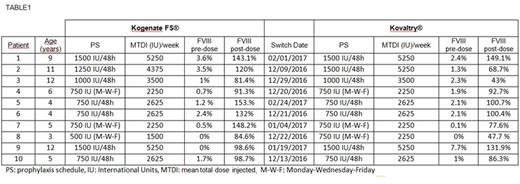Abstract
Background: Haemophilia A is an X-linked hereditary disorder caused by deficient levels of the coagulation protein factor VIII (FVIII). Standard therapy for haemophilia A comprises replacement of FVIII with plasma-derived or recombinant FVIII concentrate, which can be administered as on-demand or prophylaxis regimen. The most challenging complication of replacement therapy in hemophilia A is the occurrence of alloantibodies against infused factor FVIII, thus predisposing the patients to an increased morbidity and disability. Historically, first FVIII was isolated from cryoprecipitated plasma concentrates. Thirty years ago, after the cloning of F8 gene, therapy for hemophilia A patients underwent a new exciting era that developed technological strategies aimed to improve haemostatic efficacy and safety of the replacement factor. In this line, a new recombinant FVIII, BAY 81-8973 (octocog alfa; Kovaltry®, Bayer) has recently been introduced onto pharmaceutical market for treatment of these patients. Kovaltry® is an unmodified, full-length, recombinant FVIII concentrate with the same amino acid sequence as Kogenate FS® (Bayer), but produced with innovative manufacturing technologies that include production without addition of human- or animal-derived raw materials from purification or formulation processes, inclusion of a higher degree of sialic acid capping of N-terminal glycans on the molecular surface, coexpression of the human chaperone protein heat shock protein 70, and a 20-nm nanofiltration step to remove small non-enveloped viruses and potential protein aggregates. On this basis we considered beneficial for our patients changing Kogenate FS® therapy for Kovaltry®.
Objective: We aimed to demonstrate that switching from Kogenate FS® to Kovaltry® could be easily performed without increasing the risk of bleeding or FVIII consumption in severe haemophilia A patients.
Methods: Sixty two adult and pediatric patients with severe haemophilia A, without inhibitors, treated with Kogenate FS® either on on-demand treatment (n=13) or on prophylaxis regimen (n=49), were recruited. On November 2016, we began to switch Kogenate FS® treatment to Kovaltry® in these patients.
The trend of prophylaxis with Kovaltry® was evaluated by determining mean injection frequency (per week), mean dose of each injection (IU/kg), mean total dose injected/week (IU), baseline and post-infusion levels of FVIII and annual bleeding rate (ABR). Same data for Kogenate FS® were collected retrospectively from clinical histories of patients.
For determining baseline and post-infusion levels of Kovaltry®, whole blood was collected in 3.2% sodium citrate tubes (BD Vacutainer, Becton Dickinson, San José, CA, USA) at pre-dosing and 30 minutes after Kovaltry® infusion. Plasma FVIII:C was measured by chromogenic assay.
Results: Switching from Kogenate FS® to Kovaltry® caused no changes, except in two patients, either in mean injection frequency or mean dose of each injection or mean total dose injected/week or baseline and post-infusion levels of FVIII or annual bleeding rate. Increment observed in mean total dose injected/week in two of the pediatric patients was due to an increased physical activity (patient 2) and to weight gain (patient 8). For sake of example, Table 1 shows these variables for 10 pediatric patients under prophylactic treatment.
None of the patients treated with Kovaltry® developed inhibitors.
Conclusion: Changing severe haemophilia A treatment from Kogenate FS® to Kovaltry® can be performed easily and did not pose any risk to the patient since Kovaltry® proved to be equally effective than Kogenate FS® to prevent bleeding episodes and did not induce the occurrence of inhibitors.
Álvarez-Roman: Novo Nordisk: Consultancy; Shire: Consultancy. Jimenez-Yuste: Novo Nordisk: Consultancy, Honoraria, Research Funding; Roche: Consultancy.
Author notes
Asterisk with author names denotes non-ASH members.


This feature is available to Subscribers Only
Sign In or Create an Account Close Modal